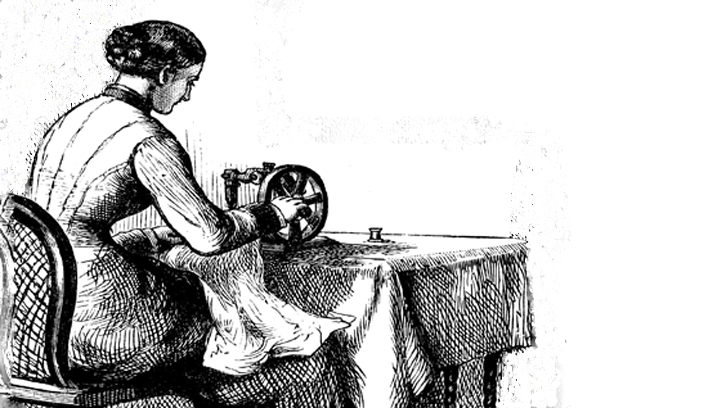“They sew to sell”: eighteenth-century women’s work and structural change

In this research, my initial goal was to use householders’ declarations in the Cadaster of Ensenada to calculate labour participation rates for women and men in inland Spain. Conducted between 1750 and 1755, the Cadaster was a general property survey carried out with the aim of modernizing and unifying the fiscal system of the Kingdom of Castile (about three-quarters of modern Spain). Most householders did not declare the occupations of their wives or children, since wages earned by wives and children would not be taxed. But in some towns, householders did declare the occupations of their wives and children, and town clerks recorded the information.
I belong to the General estate, my trade fuller, married, my family is formed by myself, 46 years old, Ynés López Zamorano, 40 years old. I have four daughters, Agustina, 20, her occupation weaver, Isabel, 13, her occupation spinning, María, 11, her occupation going to sewing school, María Teresa, 2 months.
Based on a database currently comprising 44,484 individuals (the population of 22 localities in five provinces of southern Castile), this article shows that men’s participation rates ranged from 78.2 to 92.5%. In the largest localities, men’s participation rates were lower because these towns or cities had greater social differentiation. Nonworking members of the nobility, beggars, and monks were concentrated there.
The article also establishes the actual levels of women’s market activity, which were much higher than is commonly assumed. For the entire region, women’s participation rate was 32.3 percent. Differences in participation rates among localities were much larger for women than for men, ranging from 12.4% in Pedro Muñoz to 82.7 % in Villamanrique. While these large differences could theoretically reflect different employment opportunities for women, the lower rates were mostly due to the way women’s work was recorded, or rather, unrecorded. Ajofrín, in Toledo, was a prosperous production centre for woolen fabrics, with a population of 3,308 in 1753. According to householders’ declarations, 82.4% of men but only 25.3% of women were gainfully employed. However, in response to a Cadaster question about the number of poor people who lived in town, the town council responded, ‘Only eight, as everybody is devoted to the work of wool, particularly women, even the oldest ones.’
The Cadaster also makes it possible to analyse the region’s deeply gendered occupational structure. The primary sector occupied 60.0 percent of working-age men, but only 2.9% of working-age women. Men’s primary-sector employment was lower in towns, while women’s presence in the primary sector ranges from none in some localities to 35.3% in others, where, for instance, flax cultivation was important.
The service sector occupied 16.4% of working men and 34.4% of working women. Within the sector, domestic service employed 84.4 % of women and 17.8% of men. For women, domestic service correlates with the size of the town and with the number of households headed by priests. For men, service occupations were more diversified, including transportation and retailing.
This research’s most interesting and consequential results lie in the industrial sector. Due to the labour-intensiveness of manufacturing work, the abundant supply of cheap labour, the diffusion of cottage industries, and the demand for commodities (particularly textiles) from internal and colonial markets, a large portion of the region’s population worked in manufactures in the eighteenth century. The secondary sector occupied 23.6% of working men and 62.8% of working women.
Here we can see the occupational distribution of women and men, 18th century inland Spain.
While the region’s two royal factories, which employed mostly men, account for the unusually high share of men in industry, women’s even stronger presence in manufactures was explained, albeit indirectly, by contemporary observers such as Larruga.
The trade that people from La Mancha carry out, within the court, of stockings, bonnets, knitted socks, girdles and garters is from their mills. The merchant associations do not agree with this freedom.
The importance of these manufactures has gone largely unnoticed in the scholarly literature, which has tended to describe them as for family consumption. But the kind of finished goods produced—stockings, lace, scarfs, bonnets, knitted socks, girdles, garters, bedspreads, ribbons, and edgings—clearly indicates that this part of women’s work was intended for the market. And householders’ declarations make clear that women’s textile work was indeed for the market: ‘spinning and other women’s work to gain for our food,’ ‘making stockings and weaving, upon which I maintain myself,’ ‘sewing, spinning and other womanly works to maintain myself.’
According to census data, in 1877 the share of the Spanish labour force in industry was 14.4%, while agriculture’s share was 66.1%. Agriculture’s share of the labour force would not fall below 50% until 1930. Standard interpretations of economic growth and modernization see such a large share of agricultural employment as an indicator of economic backwardness. Economic development is understood as a more or less steady march by labour from agricultural to non-agricultural occupations. Yet this grand narrative of growth and structural change relies on structural decompositions of the male labour force alone.
By taking women’s work into account, my research goes beyond correcting participation rates and occupational shares, to modify the existing narrative of structural change. My findings for Spain are consistent with recent literature showing that in many European regions non-agricultural employment followed a U-shaped curve, with the share of industrial workers higher in the eighteenth century than in the nineteenth century, mostly because of women’s work in labour-intensive, low-productivity textile manufactures.
La Mancha failed to industrialize in the nineteenth century. The invasion of the Napoleonic army in 1808 and the subsequent war led to widespread destruction of sheep flocks and infrastructure, abandonment of agricultural lands, inflation, and severe demographic crisis. National and international commercial networks were disrupted, causing a huge rise in the price of imports, and aggravating endogenous problems. Later in the century, as agricultural property was disentailed, the share of the labour force in agriculture grew rather than shrank. When spinning and the production of lace, ribbons, bonnets, socks, girdles, and garters were eventually mechanized, thousands of women and girls lost their jobs. Manufacturing employment fell across the country, even in the regions that industrialized. Women found fewer employment opportunities in the countryside, and many eventually moved to the cities to work in domestic service. Only by considering women workers is it possible to understand when, where, why, and how this structural change happened.
Universitat Autònoma de Barcelona
References
Sarasúa, Carmen. (2018). Women's work and structural change: occupational structure in eighteenth‐century Spain. The Economic History Review, 72 (2) (2019), pp. 481-509.
For more information:
http://www.carmensarasua.es/


